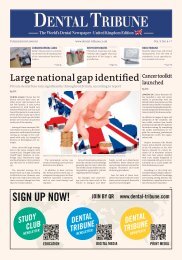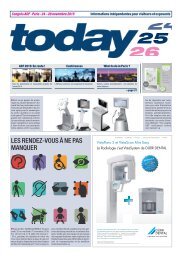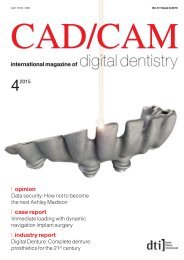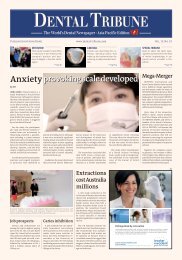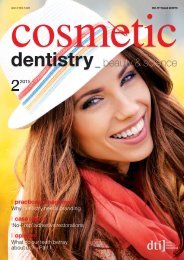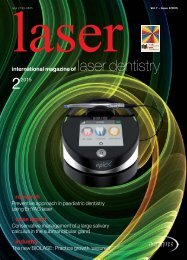today EOS Congress Venice 2015
From 13 to 18 June, the European Orthodontic Society is holding its annual congress in Venice. Dental Tribune International published a new issue of its today congress and trade show newspaper.
From 13 to 18 June, the European Orthodontic Society is holding its annual congress in Venice. Dental Tribune International published a new issue of its today congress and trade show newspaper.
You also want an ePaper? Increase the reach of your titles
YUMPU automatically turns print PDFs into web optimized ePapers that Google loves.
06 science & practice<br />
<strong>EOS</strong> <strong>Venice</strong> <strong>2015</strong><br />
Pre-orthodontic options for 21 st -century parents<br />
By Daniel Elliott, Myofunctional Reasearch<br />
As a matter of routine, when accepting<br />
an orthodontic treatment<br />
plan, parents are required to acknowledge<br />
the risk that their<br />
children’s teeth could be damaged<br />
during treatment. At best, unless<br />
they commit to permanent use of a<br />
retainer, patients can expect almost<br />
definite relapse and worst-case scenarios<br />
may include enamel damage,<br />
root resorption or in the case of corrective<br />
jaw surgery, painful lifelong<br />
complications.<br />
Unfortunately, though, while parents<br />
are becoming more aware of the<br />
risks and limitations of traditional<br />
orthodontics and the generating impetus<br />
toward more stable, less invasive<br />
treatments, they are often not<br />
being informed of all the alternative<br />
options that are available.<br />
20 th June 2011 1 st August 2013 20 th June 2011 1 st August 2013<br />
<br />
Fig.1: Preventive, pre-orthodontic treatments can be undertaken and completed much sooner than or, if necessary, even in conjunction with, braces and can produce outcomes superior to those achieved using a single treatment<br />
method.—Fig. 2: 21 st -century parents are increasingly enthusiastic about treatment systems which package myofunctional habit correction, arch expansion and dental alignment into one integrated system.<br />
Despite this increased recognition<br />
of the shortcomings of traditional<br />
orthodontic treatments and<br />
the escalating demand for contemporary<br />
options, the causes of mal -<br />
AD<br />
occlusion remain somewhat hidden<br />
from parents. In order to make an<br />
informed decision regarding their<br />
children’s oral health and to decide<br />
which treatment is the most suitable,<br />
these causes of malocclusion<br />
must be highlighted.<br />
Three in four 21 st -century children<br />
will experience malocclusion<br />
and parents, as well as the dental<br />
professionals advising them, have<br />
traditionally attributed this to<br />
hered itary factors. However, research<br />
shows that rather than genetics,<br />
the aetiology of malocclusion is<br />
predominately environmental.<br />
The most recent evidence, which<br />
is often not presented to parents<br />
during orthodontic consultations,<br />
reveals that the majority of mal -<br />
occlusions are caused by incorrect<br />
jaw development.<br />
This incorrect development restricts<br />
the space that is available for<br />
erupting teeth and prevents them<br />
from growing into their ideal nat -<br />
ural position. For the best part of<br />
the last century, the easiest fix for<br />
this problem has been to extract<br />
healthy permanent teeth, then to<br />
Once these myofunctional causes<br />
of malocclusion have been iden -<br />
tified, the potential for natural<br />
growth is unlocked and myofunctional<br />
treatment methods, which<br />
can produce more stable results<br />
without relying on heavy me -<br />
chanical forces, become possible.<br />
Ad ditionally, these preventive,<br />
pre- orthodontic treatments can be<br />
undertaken and completed much<br />
sooner than, or even in conjunction<br />
with, braces if necessary.<br />
In fact, combining pre-orthodontic<br />
preventive treatment with less<br />
invasive orthodontic techniques<br />
can produce outcomes far superior<br />
to those achieved using a single<br />
treatment philosophy.<br />
As a result of improved awareness<br />
regarding their children’s oral<br />
1 Year Clinical Masters TM Program<br />
in Aesthetic and Restorative Dentistry<br />
12 days of intensive live training with the Masters in Athens (GR) and Geneva (CH)<br />
Three sessions with live patient treatment, hands-on practice, plus<br />
online training under the Masters’ supervision.<br />
“Three in four 21 st -century<br />
children will experience<br />
malocclusion...”<br />
Learn from the Masters of Aesthetic and Restorative Dentistry:<br />
Registration information:<br />
12 days of live training with the Masters<br />
in Athens (GR), Geneva (CH) + self study<br />
Curriculum fee: €9,900<br />
(Based on your schedule, you can register for this program one session at a time.)<br />
Collaborate<br />
on your cases<br />
and access hours of<br />
premium video training<br />
and live webinars<br />
University<br />
of the Pacific<br />
you will receive<br />
a certificate from the<br />
University of the Pacific<br />
Tribune Group GmbH is the ADA CERP provider. ADA CERP is a service<br />
of the American Dental Association to assist dental professionals in<br />
identifying quality providers of continuing dental education. ADA CERP<br />
does not approve or endorse individual courses or instructors, nor does it<br />
imply acceptance of credit hours by boards of dentistry.<br />
Details on www.TribuneCME.com<br />
C.E.<br />
100 CREDITS<br />
contact us at tel.: +49-341-484-74134<br />
email: request@tribunecme.com<br />
Tribune Group GmbH i is designated as an Approved PACE Program Provider by the<br />
Academy of General Dentistry. The formal continuing dental education programs of this<br />
program provider are accepted by AGD for Fellowship, Mastership, and membership<br />
maintenance credit. Approval does not imply acceptance by a state or provincial board of<br />
dentistry or AGD endorsement.<br />
use braces to align the remaining<br />
teeth into underdeveloped jaws.<br />
Unfortunately, for countless orthodontic<br />
patients, these mechanical<br />
treatments are focused on the<br />
symptoms of malocclusion, but fail<br />
to address the underlying causes of<br />
the condition, which is why relapse<br />
is the most predictable outcome.<br />
An increasing number of dental<br />
professionals have accepted the necessity<br />
for new treatment methods<br />
that would address the causes,<br />
rather than just correcting the<br />
symptoms, of malocclusion.<br />
These practitioners recognise<br />
that in addition to environmental<br />
factors (such as the modern diet)<br />
inhibited jaw development is being<br />
caused by poor myofunctional<br />
habits, including thumb sucking,<br />
reverse swallowing and mouth<br />
breathing.<br />
health care, 21 st -century parents<br />
have become increasingly enthusiastic<br />
about less invasive, more preventive<br />
treatment methods. Legally<br />
these parents should be presented<br />
with all the treatment options that<br />
are available.<br />
Although patient compliance<br />
with functional appliances and<br />
myofunctional therapy techniques<br />
has historically restricted the widespread<br />
acceptance of these treatments,<br />
modern techniques have<br />
addressed these concerns. There<br />
are now treatment systems that<br />
package myofunctional habit correction,<br />
arch expansion and dental<br />
alignment into one integrated<br />
system that satisfies the parents’<br />
demand for modern, early preorthodontic<br />
techniques. <br />
Editorial Note: This text was first published<br />
in the 03/2014 issue of the Ortho<br />
Tribune US Edition.



